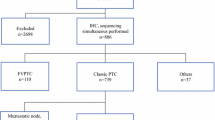Abstract
The BRAF V600E mutation is specific for thyroid papillary cancer (PTC) and correlates with PTCs invasiveness. This study investigated whether detection of BRAF V600E mutation can be performed on routinely stained FNABs. We also examined if establishment of the BRAF V600E mutation could help in identification of patients at higher risk for metastatic disease. DNA was isolated from 134 FNABs samples (20 follicular neoplasm, ten suspicious for malignancy, and 104 malignant) using Pinpoint Slide DNA Isolation System. BRAF V600E mutation was detected by PCR followed by sequencing. DNA was successfully extracted from all examined FNABs samples. In follicular neoplasm, suspicious for malignancy and malignant FNABs, BRAF V600E mutation was found in 0/20 (0%), 2/10 (20%), and 47/104 (45.2%) of cases, respectively. Extra-thyroidal extension was detected in 35/47 (74.4%) BRAF V600E positive and in 24/57 (42.1%) wild-type BRAF cases (p = 0.001). Metastases were detected in 37/47 (78.7%) BRAF V600E positive and in 28/57 (49.1%) wild-type BRAF cases (p = 0.002). Our results showed that stained FNAB specimens can be used for DNA extraction and assessment of BRAF V600E mutation. Detection of BRAF V600E mutation had limited value in diagnoses of malignancy in follicular neoplasms but can ascertain malignancy in subset of suspicious for malignancy FNABs. In malignant FNABs, BRAF V600E mutation was significantly associated with presence of extra-thyroidal extension and metastases after surgery.
Similar content being viewed by others
References
Aschebrook-Kilfoy, B., et al., Thyroid cancer incidence patterns in the United States by histologic type, 1992–2006. Thyroid, 2011. 21(2): p. 125–34.
Yu, G.P. and S.P. Schantz, Extent of surgery affects papillary thyroid cancer. Ann Surg, 2009. 249(3): p. 549–50; author reply 550
Elaraj, D.M. and C. Sturgeon, Adequate surgery for papillary thyroid cancer. Surgeon, 2009. 7(5): p. 286–9.
Baloch, Z., et al., Role of repeat fine-needle aspiration biopsy (FNAB) in the management of thyroid nodules. Diagn Cytopathol, 2003. 29(4): p. 203–6.
Sidoti, M., et al., The rational use of fine needle aspiration biopsy (FNAB) in diagnosing thyroid nodules. Minerva Endocrinol, 2006. 31(2): p. 159–72.
Wang, C.C., et al., A large multicenter correlation study of thyroid nodule cytopathology and histopathology. Thyroid, 2010. 21(3): p. 243–51.
Famakinwa, O.M., et al., ATA practice guidelines for the treatment of differentiated thyroid cancer: were they followed in the United States? Am J Surg, 2010. 199(2): p. 189–98.
Solorzano, C.C., et al., Surgeon-performed ultrasound in the management of thyroid malignancy. Am Surg, 2004. 70(7): p. 576–80; discussion 580–2
Stulak, J.M., et al., Value of preoperative ultrasonography in the surgical management of initial and reoperative papillary thyroid cancer. Arch Surg, 2006. 141(5): p. 489–94; discussion 494–6
Leboulleux, S., et al., Ultrasound criteria of malignancy for cervical lymph nodes in patients followed up for differentiated thyroid cancer. J Clin Endocrinol Metab, 2007. 92(9): p. 3590–4.
Xing, M., BRAF mutation in papillary thyroid cancer: pathogenic role, molecular bases, and clinical implications. Endocr Rev, 2007. 28(7): p. 742–62.
Vasko, V., et al., High prevalence and possible de novo formation of BRAF mutation in metastasized papillary thyroid cancer in lymph nodes. J Clin Endocrinol Metab, 2005. 90(9): p. 5265–9.
Xing, M., et al., BRAF mutation predicts a poorer clinical prognosis for papillary thyroid cancer. J Clin Endocrinol Metab, 2005. 90(12): p. 6373–9.
Xing, M., et al., BRAF mutation testing of thyroid fine-needle aspiration biopsy specimens for preoperative risk stratification in papillary thyroid cancer. J Clin Oncol, 2009. 27(18): p. 2977–82.
Nikiforov, Y.E., et al., Molecular testing for mutations in improving the fine-needle aspiration diagnosis of thyroid nodules. J Clin Endocrinol Metab, 2009. 94(6): p. 2092–8.
Troncone, G., et al., Preparation of thyroid FNA material for routine cytology and BRAF testing: a validation study. Diagn Cytopathol, 2010. 38(3): p. 172–6.
Knauf, J.A., et al., Progression of BRAF-induced thyroid cancer is associated with epithelial-mesenchymal transition requiring concomitant MAP kinase and TGFbeta signaling. Oncogene, 2011. 30(28): p. 3153–62
Nikiforov, Y.E., Thyroid carcinoma: molecular pathways and therapeutic targets. Mod Pathol, 2008. 21 Suppl 2: p. S37-43.
Kebebew, E., et al., The prevalence and prognostic value of BRAF mutation in thyroid cancer. Ann Surg, 2007. 246(3): p. 466–70; discussion 470–1
Nikiforova, M.N., et al., BRAF mutations in thyroid tumors are restricted to papillary carcinomas and anaplastic or poorly differentiated carcinomas arising from papillary carcinomas. J Clin Endocrinol Metab, 2003. 88(11): p. 5399–404.
Proietti, A., et al., BRAF status of follicular variant of papillary thyroid carcinoma and its relationship to its clinical and cytological features. Thyroid, 2010. 20(11): p. 1263–70.
Author information
Authors and Affiliations
Corresponding author
Rights and permissions
About this article
Cite this article
Patel, A., Klubo-Gwiezdzinska, J., Hoperia, V. et al. BRAF V600E Mutation Analysis from May-Grünwald Giemsa-Stained Cytological Samples as an Adjunct in Identification of High-Risk Papillary Thyroid Carcinoma. Endocr Pathol 22, 195–199 (2011). https://doi.org/10.1007/s12022-011-9180-9
Published:
Issue Date:
DOI: https://doi.org/10.1007/s12022-011-9180-9




